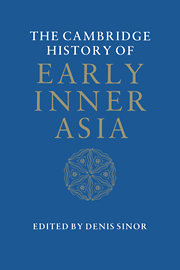Book contents
- Frontmatter
- 1 Introduction: the concept of Inner Asia
- 2 The geographic setting
- 3 Inner Asia at the dawn of history
- 4 The Scythians and Sarmatians
- 5 The Hsiung-nu
- 6 Indo-Europeans in Inner Asia
- 7 The Hun period
- 8 The Avars
- 9 The peoples of the Russian forest belt
- 10 The peoples of the south Russian steppes
- 11 The establishment and dissolution of the Türk empire
- 12 The Uighurs
- 13 The Karakhanids and early Islam
- 14 Early and medieval Tibet
- 15 The forest peoples of Manchuria: Kitans and Jurchens
- Bibliography
- Index
- References
14 - Early and medieval Tibet
Published online by Cambridge University Press: 28 March 2008
- Frontmatter
- 1 Introduction: the concept of Inner Asia
- 2 The geographic setting
- 3 Inner Asia at the dawn of history
- 4 The Scythians and Sarmatians
- 5 The Hsiung-nu
- 6 Indo-Europeans in Inner Asia
- 7 The Hun period
- 8 The Avars
- 9 The peoples of the Russian forest belt
- 10 The peoples of the south Russian steppes
- 11 The establishment and dissolution of the Türk empire
- 12 The Uighurs
- 13 The Karakhanids and early Islam
- 14 Early and medieval Tibet
- 15 The forest peoples of Manchuria: Kitans and Jurchens
- Bibliography
- Index
- References
Summary
Pre- and early history
At our present level of knowledge, we cannot define with certainty the boundaries between pre- and early history. This is due, on the one hand, to the fact that systematic excavations in Tibet and bordering regions have not yet been possible, nor are they to be expected in the near future. On the other hand we have access to the ancient Chinese historical works which contain historical and ethnographical data on the “barbarian peoples,” information which we must certainly use in spite of the fact that it is frequently adulterated with contemporary interpolations. In such sources one must also distinguish between the data which refer to those peoples who directly bordered the Chinese upland and had trade or military relations with the Chinese, and the data on those peoples who are merely mentioned from hearsay but had no direct contact with the Chinese and concerning whom certain “barbarian clichés” existed which, of course, have no historical value. Frequent mention is made for instance of the immorality of women who belonged to the various foreign peoples, information which simply shows that they had different sexual mores from those acceptable in China. Among the Tibetans and related peoples this would refer to the social institution of polyandry.
When we turn to the few available archeological finds, it is evident that their value is rather meager, consisting as they do of objects which have been found on the earth's surface or were unearthed by a slight scratching of the soil and that quite by chance.
- Type
- Chapter
- Information
- The Cambridge History of Early Inner Asia , pp. 371 - 399Publisher: Cambridge University PressPrint publication year: 1990
References
- 1
- Cited by



